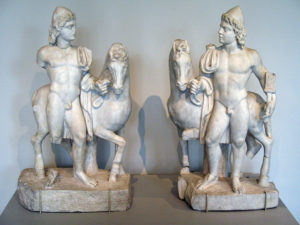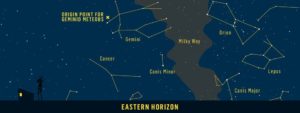[9] τοῦ Ποσειδῶνος δέ εἰσιν ἐπειργασμένοι τῷ βάθρῳ καὶ οἱ Τυνδάρεω παῖδες, ὅτι δὴ σωτῆρες καὶ οὗτοι νεῶν καὶ ἀνθρώπων εἰσὶ ναυτιλλομένων. τὰ δὲ ἄλλα ἀνάκειται Γαλήνης ἄγαλμα καὶ Θαλάσσης καὶ ἵππος εἰκασμένος κήτει τὰ μετὰ τὸ στέρνον, Ἰνώ τε καὶ Βελλεροφόντης καὶ ὁ ἵππος ὁ Πήγασος.
- Map
- Pre Reading
- Post Reading
- Culture Essay
What do we know about the twin brothers whom Pausanias names as the “sons of Tyndareus”? Homer describes the twins as Castor the horse tamer and Pollux the boxer (Il. 3.237-8). Yet in time both come to be known as “riders of swift horses” (Homeric Hymn 17). In our earliest sources, sometimes they are the sons of Zeus, the Dioscuri (Διόσκουροι), and other times they are the sons of the mortal Tyndareus, the Tyndaridae (Τυνδαρίδαι). However, by the time of the Cypria and Pindar, most sources recognize that Castor (Κάστωρ) was born from Tyndareus while Pollux (Πολυδεύκης) has a divine father, Zeus. In the Odyssey we learn that the twins share the same status in the Underworld, “enjoying the honor of Zeus,” alive one day and dead the next (Od. 11.301-4). Pindar provides a fuller account of their afterlife in Nemean Ode 10. When Castor was at the point of death, Pollux was given the choice of immortality for himself and death for Castor or of spending alternate days on Olympus or in Hades. Pollux chose the latter, giving the two brothers a share of both immortality and death.
The twins were especially connected with protecting seafarers. In Homeric Hymn 33, Leda gives birth to the twins, “saviors of people on earth and swift-moving ships.” When a storm arises, those on the ship pray to Zeus. Then, “the strong wind and the swell of the sea put the ship under water, but suddenly the two brothers appear, darting on tawny wings through the air. At once, they calm the blasts of the harsh winds and quell the waves. . . . They [the sailors] have seen these two fair signs of deliverance from distress.” The twins’ appearance was associated with the weather phenomenon St. Elmo’s fire, in which a double light or corona appears around the mast or sails of a ship in a storm.
To learn more about their Indo-European roots, read Boaz Vilallonga, “The Divine Twins in Indo-European Religion: Horses, Chariot, the Sun, Dawn and the Sky Father: From Rome to India a Consistent Myth Has a Proto-Indo-European Origin” Medium 24 Mar 2019.
How many Poseidons are present in the sanctuary at Isthmia? Why do sanctuaries have multiple copies of statues? Why are both Ino and Bellerophon and Pegasos found in the Sanctuary of Poseidon at Isthmia?
After reading Pausanias’ description of the sanctuary at Isthmia (2.1.7-9), draw one or more pictures depicting the statues and monuments mentioned by Pausanias in the correct location and labeling each in Greek. Stick figures are just fine.

